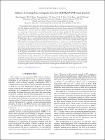| dc.contributor.author | COEY, JOHN | en |
| dc.date.accessioned | 2014-04-22T11:04:26Z | |
| dc.date.available | 2014-04-22T11:04:26Z | |
| dc.date.issued | 2012 | en |
| dc.date.submitted | 2012 | en |
| dc.identifier.citation | Stearrett, R, Wang, WG, Kou, XM, Feng, JF, Coey, JMD, Xiao, JQ, Nowak, ER, Influence of exchange bias on magnetic losses in CoFeB/MgO/CoFeB tunnel junctions, Physical Review B, 86, 2012, 014415- | en |
| dc.identifier.other | Y | en |
| dc.identifier.uri | http://hdl.handle.net/2262/68523 | |
| dc.description | PUBLISHED | en |
| dc.description.abstract | Thestrengthoftheexchangebiasfieldisfoundtoinfluencethelow-frequencymagnetoresistivenoiseassociated
with the magnetic reference layer in sputtered-deposited and electron-beam-evaporated CoFeB/MgO/CoFeB
tunnel junctions. The noise is due to magnetic losses arising in the reference layer. The losses are parameterized
by a phase lag
?
which exhibits a nontrivial dependence on the externally applied field. The general trend found
among all devices is that the losses are largest in the antiparallel state. The effect of exchange bias on the reference
layer?s noise is investigated at a field corresponding to maximum resistance susceptibility,
H
ref
. Higher values for
the phase lag at
H
ref
,
?
ref
, are found in devices having a large exchange bias field. We also observed that
H
ref
and
?
ref
are larger in devices having thicker seed layers. This characteristic is also evident in double-barrier magnetic
tunneljunctions.Prolongedthermalannealingisfoundtodecrease
?
ref
,reduce
H
ref
,andalterthefieldprofileofthe
resistance susceptibility of the reference layer to resemble that of a more magnetically soft behavior. In addition
to its impact on the magnetoresistive noise, the incorporation of exchange bias layers into the materials stack also
affectsthetunnelingmagnetoresistanceratiowithhighervaluesfoundatsmallerexchangebiasfields.Weattribute
the magnitude of the magnetic losses, and hence the magnetoresistive noise, from the reference layer to disorder
in its magnetic microstructure. Our results indicate that the nature and degree of disorder are correlated to the
strengthoftheexchangebiascoupling.Theoriginofthiscorrelationmaybeduetoacompetitionbetweendifferent
microstructures among various layers, one that leads to coherent tunneling (large tunneling magnetoresistance)
in MgO-based tunneling devices and the other which promotes strong exchange bias coupling. A decrease in the
exchange bias either through degradation from thermal treatments or by varying the thickness of the underlying
seed layer will lead to less magnetic disorder in the system. We show that the magnetoresistive noise can be used
to probe magnetic disorder in exchange-biased devices through the determination of the magnetic losses. | en |
| dc.description.sponsorship | This work was supported by the DOE under Award No.
DE-FG02-07ER46374. The work of R.S. was supported in
part by NASA?s Delaware Space Grant program | en |
| dc.format.extent | 014415 | en |
| dc.language.iso | en | en |
| dc.relation.ispartofseries | Physical Review B | en |
| dc.relation.ispartofseries | 86 | en |
| dc.rights | Y | en |
| dc.subject | Physics | en |
| dc.title | Influence of exchange bias on magnetic losses in CoFeB/MgO/CoFeB tunnel junctions | en |
| dc.type | Journal Article | en |
| dc.type.supercollection | scholarly_publications | en |
| dc.type.supercollection | refereed_publications | en |
| dc.identifier.peoplefinderurl | http://people.tcd.ie/jcoey | en |
| dc.identifier.rssinternalid | 93662 | en |
| dc.identifier.doi | http://dx.doi.org/10.1103/PhysRevB.86.014415 | en |
| dc.rights.ecaccessrights | OpenAccess | |
| dc.contributor.sponsor | Department of Energy | en |




